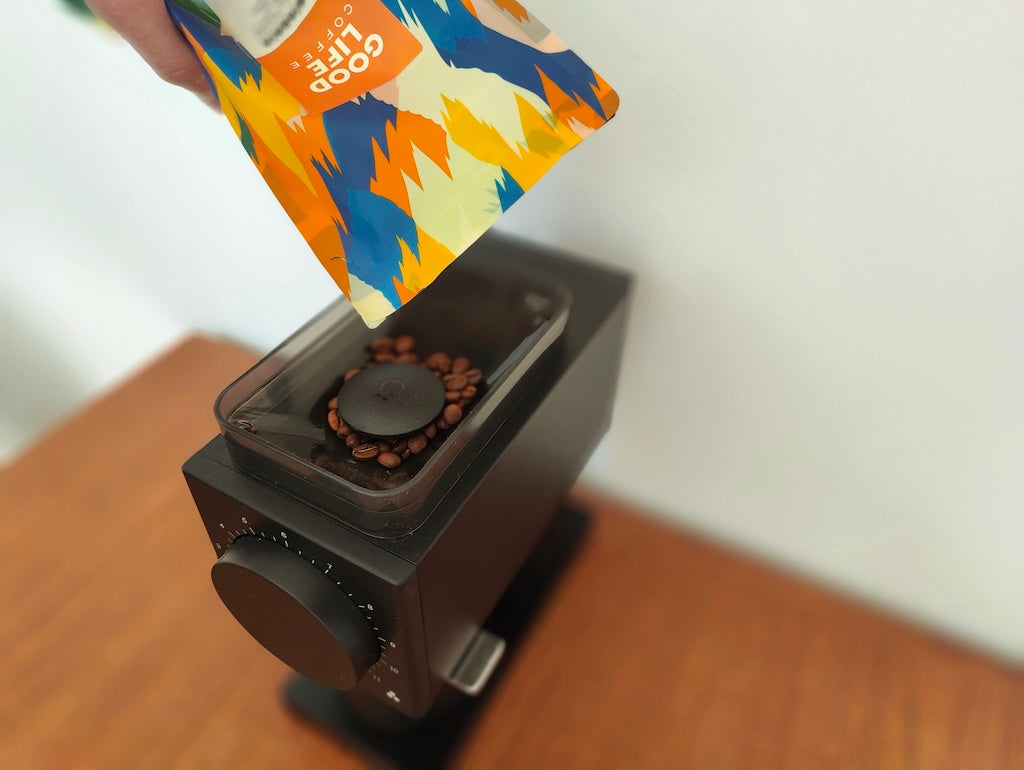Why Grinding Matters
Grinding is a necessary step before brewing, as coffee can’t be made from whole beans. Grinding releases the aromas and flavors locked inside the beans, which then extract into water at different rates depending on the grind size and brewing method.
Even if you have the finest beans and perfect water, the wrong grind size can ruin your cup. Every brewing method has its own ideal grind size. By grinding your beans fresh, you can always match the grind to your preferred method and coffee.
Grind Sizes for Different Brewing Methods
As a rule of thumb, the faster the brew time, the finer the grind – and vice versa.
Espresso: very fine and consistent, almost powdery
AeroPress and Moka Pot: medium-fine to fine
Filter (drip): medium-coarse, slightly coarser than sugar
French Press: coarse and visibly grainy
What to Consider When Choosing a Coffee Grinder
So, what’s the best grinder for you? There are a few things to think about depending on your needs and budget.
Burrs
Grinders come with either blade or burr mechanisms. Always go for burrs.
Blade grinders chop beans unevenly, giving you a messy mix of dust and chunks. Burr grinders, on the other hand, crush beans between two grinding surfaces until they reach a consistent size.
Burrs come in flat or conical shapes and are usually made of metal. Some lower-cost models use ceramic burrs. If your budget allows, go for metal burrs – they typically produce a more consistent grind.

Motor
Along with the burrs, the motor is where most of your money goes when buying a grinder. A good motor determines how evenly, quietly, and efficiently your coffee is ground.
Cheaper grinders often run at very high RPMs to achieve the needed torque, which can cause noise and unwanted heat buildup in both the machine and the beans. This is especially critical for espresso grinding, which requires more torque to handle fine grounds without clogging.
A strong, steady motor doesn’t just power the grinder – it protects your coffee’s flavor.
A great example of a reliable, well-balanced electric grinder is Wilfa Svart Aroma. Its conical metal burrs and smooth motor deliver consistent results for everything from Moka pot to filter and French press brewing.
Grind Adjustment
Burr grinders work by adjusting the distance between the burrs, changing the grind size. Some grinders have stepped adjustments, while others allow for stepless control.
Most home grinders use stepped settings for convenience, but espresso enthusiasts often prefer stepless adjustment for more precise tuning.
If you’re looking for a grinder that can handle multiple brewing styles with a wide adjustment range, Fellow Opus is an excellent choice. It transitions effortlessly between espresso and filter settings, making it versatile and user-friendly.

Electric or Manual Grinder?
Choosing a manual grinder lets you save money by skipping one of the priciest components – the motor. High-quality manual grinders offer excellent burrs at a lower cost, and premium models are designed for smoother, easier use. While grinding fine coffee by hand takes some effort, many people enjoy the ritual. A manual grinder can be ideal for travel, small kitchens, or cozy cabin mornings. Otherwise, an electric grinder is absolutely worth the investment for its convenience and speed.
For filter and pour-over enthusiasts, Fellow Ode Brew Grinder Gen 2 is a fantastic option. It’s designed for precision and consistency, and its sleek look makes it a perfect fit for anyone who values design as much as performance.
A Few Tips for Improving Your Grind
Adjust and test: If your coffee tastes bitter, try a coarser grind. If it’s watery or weak, grind finer.
Clean your grinder: Old coffee oils can ruin the flavor.
Invest in quality: A good grinder lasts for years and gives you consistently better results.
If you’re ready to take your coffee moments to the next level, explore our full selection of coffee grinders below.👉


